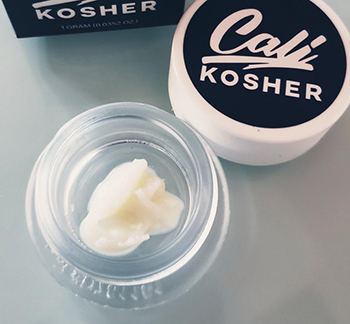You know that old saying “Guns don’t kill people, people kill people”? Well, like any firearm, so-called “CRC tech” is just a tool and although remediating the color of hash probably isn’t killing people, it sure is fooling a lot of them.
As with any tool, it is all about how you use it and the integrity of what you claim you built with it, and a Color Remediation Column is no different. The intent of the operator is as influential as the quality of the weed being extracted.
When performed properly, CRC tech will absolutely provide a pure, clean, safe product. Much like distillate. Also, like distillate, CRC-run concentrates are often stripped of most if not all the complementary cannabinoids and naturally occurring terpenes present in each specific cultivar or phenotype, leaving the consumer with almost no hope of ever experiencing a true Entourage Effect from the product.
Another old saying goes something like “If it seems too good to be true, it probably is”. So, in an era of $95 grams of cannabis extracts being commonplace on virtually every dispensary menu in America, you’re right to be skeptical of pure white wax reeking of an unnatural array of terps and sporting a price tag lower than you’re used to seeing.
As long as you know what you’re buying, that is just free-market capitalism, baby. But if, on the other hand, that price tag isn’t much lower and you’re not getting honest information about what you’re buying, CRC tech can be used to cash in on custies who just don’t know better.
Would you be able to tell the difference without an honest budtender? The Beard Bros are here to help.
COLOR REMEDIATION TECHNOLOGY (CRC TECH) IN CANNABIS
 If you have ever seen a state-of-the-art cannabis extraction lab, you might be reminded of a late-season scene from Breaking Bad, with spotless rooms full of high-priced, stainless steel, industrial-looking machinery optimized for one purpose, to extract and concentrate the active compounds of the cannabis plant.
If you have ever seen a state-of-the-art cannabis extraction lab, you might be reminded of a late-season scene from Breaking Bad, with spotless rooms full of high-priced, stainless steel, industrial-looking machinery optimized for one purpose, to extract and concentrate the active compounds of the cannabis plant.
To the untrained eye, a Color Remediation Column (the ‘CRC’ in “CRC Tech”) looks sterily similar to the rest of the stacks of silver tubes and vats in the lab but instead of being packed full of weed, a CRC is loaded with a combination of “remediation powders” like silica gel, alumina, and clay, which all act as a super-fine filtration system for already-extracted cannabis oil.
We reached out to Allen R., a sales consultant with Xtractor Depot here in Southern California for his thoughts on CRC tech and he told us, “Remediation powders are definitely a tool that can be used in different combinations for different specific reasons. The most notable would be for removing microfats and lipids from your oleoresin, though they are also known for the color pigments that they remove.”
He continues, “If used correctly, color remediation can be used to create cleaner, safer, more pure products, but there will always be people out there taking advantage of that as well.”
If not done correctly, either by operator error or hardware failure, trace amounts of the remediation powders can be inadvertently introduced and blended into the final concentrate which, clearly, defeats the entire purpose.
HONING YOUR OWN CRC RADAR
So, for those of you who don’t feel like dabbing silica gels, how can you identify which concentrates are made using CRC tech, and of those, which are still safe to dab?
First, let’s figure out how to spot CRC tech.
As with most things cannabis-related, the nose knows. One sniff will likely tell you if you are dealing with nature’s blend of terps, or a human’s attempt to emulate them.
Flavor is usually another tell-tale sign, with most cannasseurs complaining about dry, chalky vapor with excessive added terpenes like Limonene being used to mask the blandness.
Then there is the look…
We have watched the evolution of the cannabis consumer go from purging turkey-baster-blasted BHO on their cable box, to effortlessly reciting university-level chemistry knowledge, all in a decade or less.
In that time, we have watched demand rise and fall for all forms of cannabis concentrates, from wax to budder, to resin, to rosin, diamonds, sauce, and all the rest. As tastes for different textures have been all over the place, that same time period has seen consumer demand consistently rise for lighter-colored concentrates with the assumption that they must be more pure.

Though there is some truth in that, sometimes, it is not always the case and again, if it looks too good to be true, it probably is. The nearly pure white or even clear color of CRC extracts is almost always a dead giveaway.
Therein lies the problem, though, and the wiggle room for shady operators to work in – you rarely, if ever, get to see, smell, or sample a product before you buy it these days. Especially in regulated markets with their nonsensical packaging requirements.
Fortunately, the solution here is the same for both retailers looking to stock legit products and for consumers looking to buy them. It’s the same solution we have used our entire lives when seeking out the best weed.
You must know, and trust, your source.
This starts at the wholesale level. Whether you are a dealer or a dispensary, you are the face of the product in the eyes of the retail customer. Setting your bottom line aside, it is up to you to vet your vendors thoroughly to ensure that you know exactly what they are selling you so that you know exactly what you are selling to the public.
If it is clean, lab-tested, CRC tech dabs, and you got a great deal on the batch, advertise it and price it accordingly. This is how you will build that trust, as a source.
As a retail customer in the age of corporate cannabis, it is more important than ever to know and trust your source.
Whether you are seeking high-quality CRC-treated hash or if you want to avoid it at all costs, demand lab test results, and compare cannabinoid and terpene profiles to those of higher-priced products. Research and support cannabis farms and cultivators who do things the right way, without pesticides or corner-cutting. Find the extraction lab that runs their flowers and demand that brand from your local dispensary.
Consumer demand drives any industry and cannabis is no different. When we demand better, the market gets better.
(cover photo: Creative Commons)
















